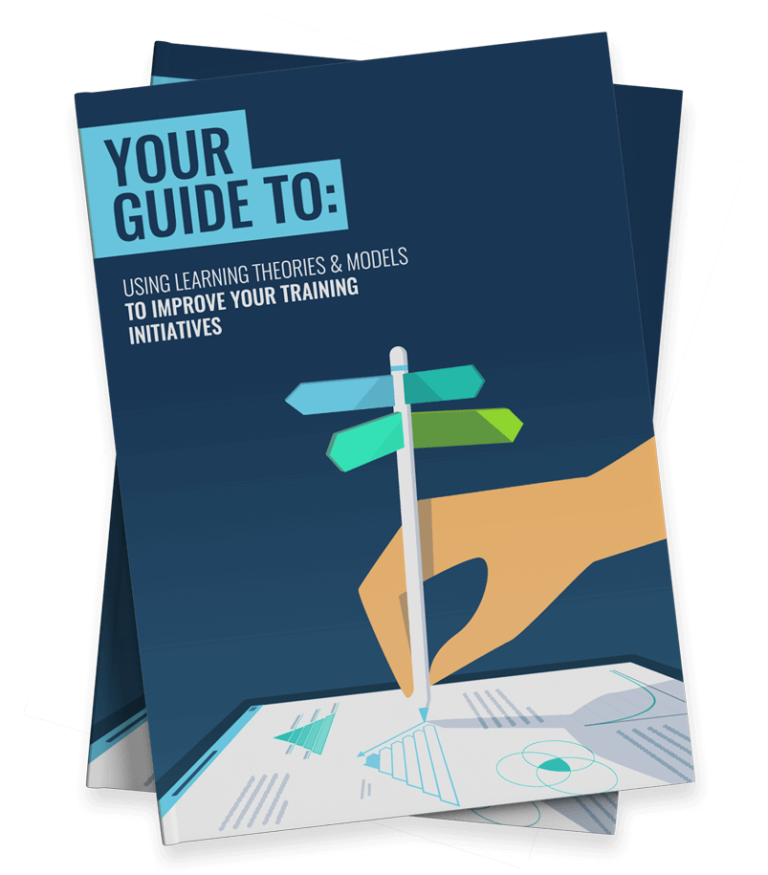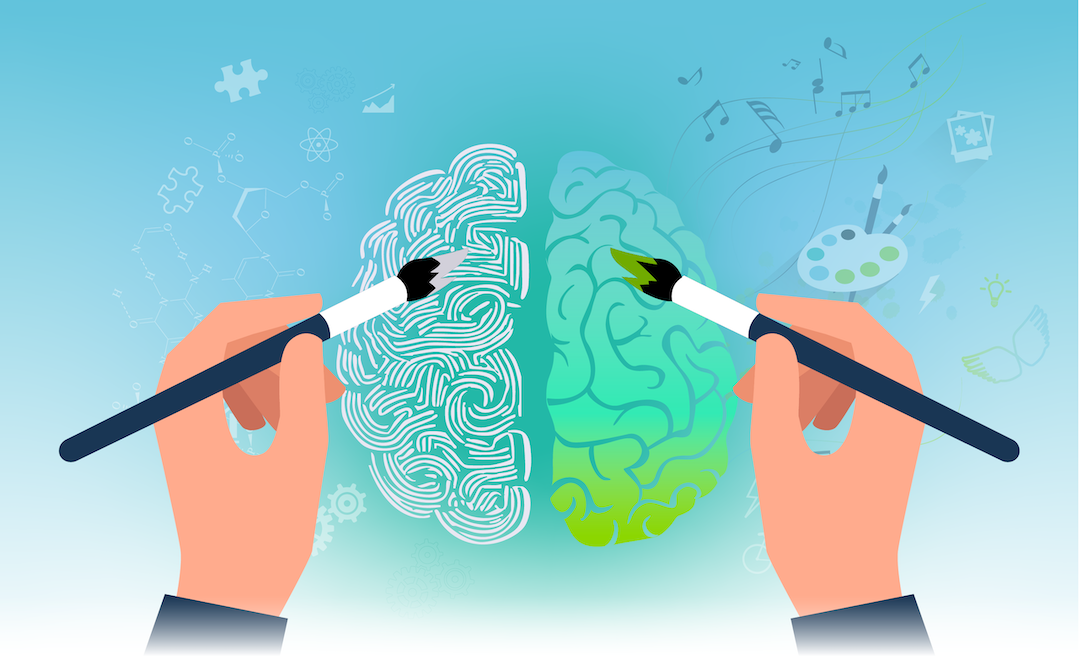
Ever wondered what really makes us tick? Abraham Maslow’s hierarchy of needs is arguably the most influential model explaining the psychology of human motivation. Whether you’re studying psychology, marketing, or education, this model helps explain why we do what we do.
Given what it tells us about the nature of human motivation and goal attainment, it’s also a very important theory for learning professionals to understand.
Maslow’s hierarchy provides us with valuable insights into the fundamental human needs and motivations that drive learner behaviour. This, in turn, can help us to refine our learning strategy and create a supportive learning environment.
In developing this hierarchy, Maslow was seeking to answer a simple but profound question: ‘It is quite true that man lives by bread alone — when there is no bread. But what happens to man’s desires when… his belly is chronically filled?’
Put another way, what happens when our basic needs are met? Over the course of this article, we will detail the theory, explore some criticisms, and examine what implications it holds for you and your learners. But first, let’s meet the man himself.
Who is Abraham Maslow?

Abraham Maslow (1908-1970) was a renowned American psychologist and humanist. He was born and raised in Brooklyn, New York. After his studies, he went on to teach psychology at Brooklyn College, Columbia University, and other prestigious institutions.
As a psychologist, his theories focused on the positive aspects of human nature. This contrasted with the prevailing psychoanalysis of his time (and behaviourism in general), which often focused on what was wrong or problematic about people.
While he’s best known for his ‘hierarchy of needs’, this wasn’t his only contribution to our understanding of psychology. He also came up with the idea of ‘peak and plateau experiences’, coined the term ‘metamotivation’, and characterised the qualities of self-actualising people.
What’s more, people credit him with the phrase, “if all you have is a hammer, everything looks like a nail”. In fact, the cognitive bias of over-relying on a familiar tool is known as ‘Maslow’s hammer’. It’s a cool name for an interesting theory.
Even today, Maslow remains a towering figure in psychology. In fact, a survey published back in 2002 ranked Maslow as the 10th most cited psychologist of the 20th century.
What is Maslow’s Hierarchy?
Maslow’s hierarchy of needs was first introduced in his 1943 paper, ‘A Theory of Human Motivation’. He came up with the idea following his study of the behavioural patterns of monkeys. In doing so, he soon noticed that certain needs took priority over others.
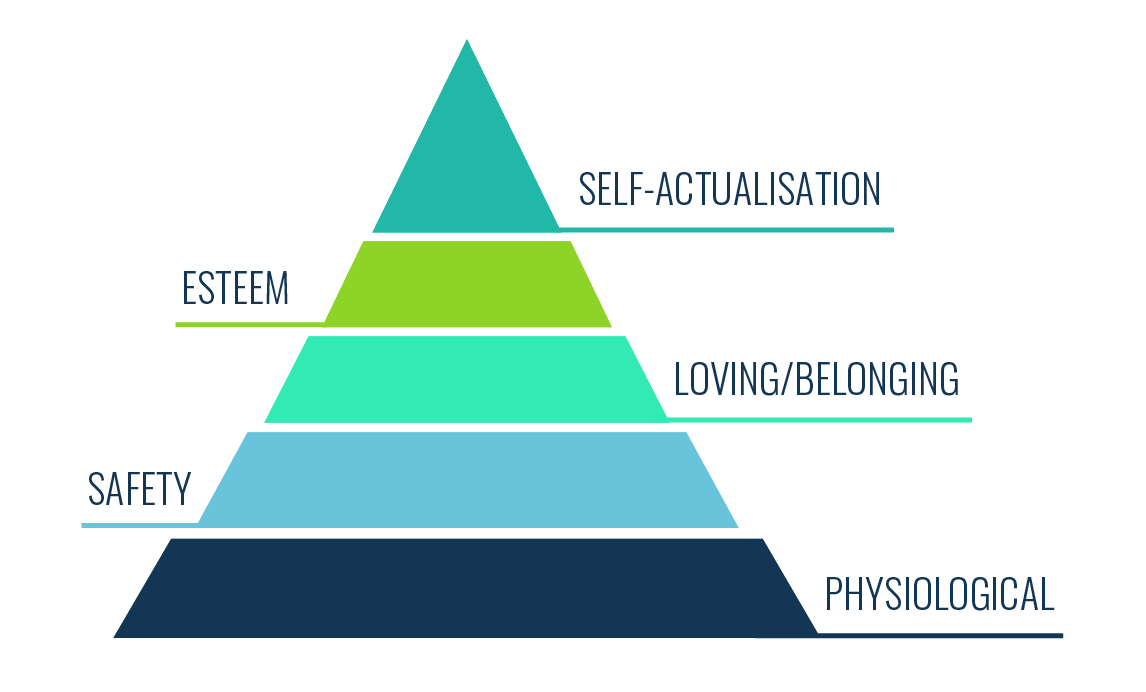
As Maslow himself puts it, ‘Human needs arrange themselves in hierarchies of pre-potency. The appearance of one need usually rests on the prior satisfaction of another, more pre-potent need.’
The theory does exactly what it says on the tin. It helps us to categorise and prioritise human needs within a five-tier model. The hierarchy is often displayed (somewhat misleadingly) as a pyramid, with basic needs at the bottom and more complex needs at the top. We can further subcategorise these needs as follows:
- The bottom two levels of the hierarchy consist of ‘basic needs’. These needs include the biological requirements for human survival.
- Levels three and four focus on our ‘psychological needs’. These needs are important for our mental wellbeing and motivation.
- The fifth and final level is a ‘growth need’. This is a need that has arisen out of our desire to improve ourselves and our standing in the world.
What Does Maslow’s Hierarchy Tell Us?
In order for our growth needs to begin to influence our behaviour, we must first satisfy our lower-level needs. That said, Maslow does not suggest that need fulfilment is an all or nothing deal. In other words, you don’t need to completely fulfil a lower level need before the next need emerges.
Indeed, Maslow held that we can never fully satisfy any of these five needs. However, he did note that we tend to have made the most progress towards our lower level needs.
Interestingly, Maslow himself never actually used a pyramid to represent his hierarchy. That was a later simplification by others. In reality, human needs don’t tend to follow such rigid tiers.
After all, specific motivations tend to peak and trough over time based on changing life circumstances. As such, his model is perhaps best represented as a series of waves plotted on a graph (source: James Chen, Frontiers in Climate).
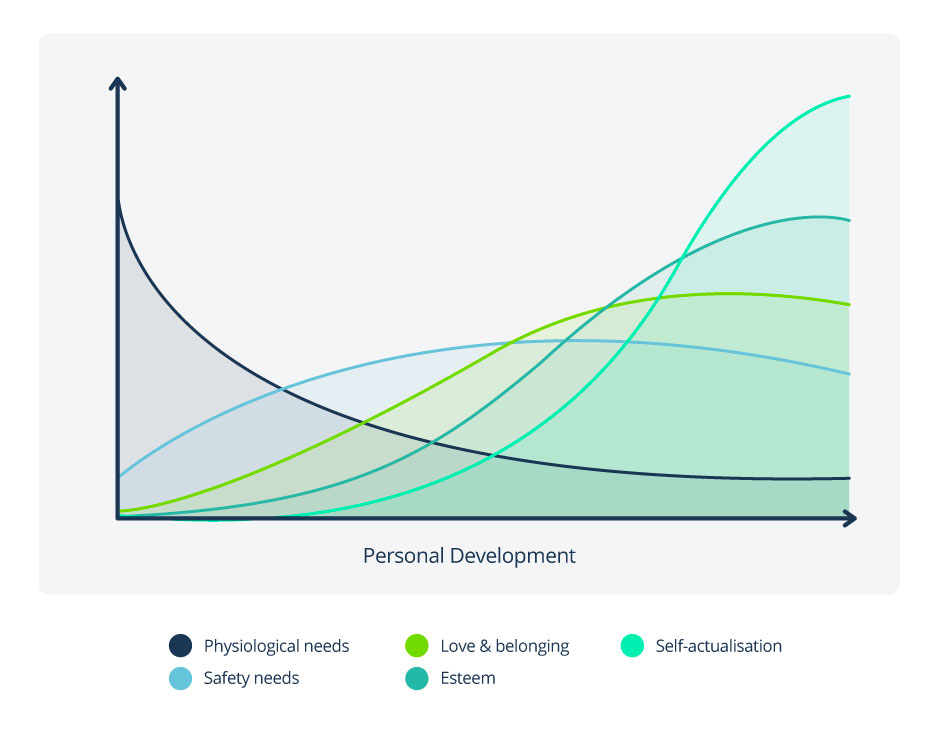
The Structure of the Hierarchy
Let’s take a closer look at the structure of the hierarchy.
- Physiological: The first level of the hierarchy consists of our physical needs. This includes needs that are vital to our survival, such as air, food, water, sex, sleep, and so on. If these basic needs aren’t met, it’s very difficult for us to focus our attention elsewhere.
- Safety: The second level of the hierarchy focuses on our need for a safe environment. This includes needs like health, security, our employment status, our property, and so on. When the safety of these assets are at risk, we tend to direct our efforts towards safeguarding the status quo.
- Love & Belonging: The third level of the hierarchy hones in on our need to feel loved and accepted. This includes needs like romantic and platonic love, family, relationships, and so on. This is all driven by a sense of ‘belonging’. It’s difficult to conjure up motivation if we don’t feel accepted and included.
- Esteem: The fourth level of the hierarchy centres on our need to feel good about ourselves. This includes needs like self-esteem, status, achievement, confidence, and so on. In other words, our value within a social context holds significant motivational power.
- Self-Actualisation: The fifth and final level of the hierarchy focuses on our need to feel purpose-driven and fulfilled. This includes growth needs like our sense of morality, creativity, problem-solving ability, and so on. If we are able to meet these needs, then we feel like we are doing what we were born to do!
Unfortunately, Maslow believed that very few individuals (‘less than 1%’) achieve true self-actualisation. After all, this would require us ‘to become everything one is capable of becoming’. Still, there’s something gratifying in the pursuit of this excellence.
Maslow claimed that he never achieved true self-actualisation. However, he did identify numerous historical figures who reached this lofty goal. They include Mahatma Gandhi, Albert Einstein, and Abraham Lincoln.
Whilst self-actualization is a rare achievement, Maslow did believe that we were all capable of it in short bursts. These are what he called ‘peak experiences’.
Research & Criticism of Maslow’s Hierarchy
Unfortunately, Maslow’s hierarchy lacks empirical evidence. In fact, many of his theories were based on his own observations and experiences. Indeed, his work on self-actualisation is founded on a biographical analysis that is limited in scope. It’s also difficult to test the hierarchy properly.
That said, there have been attempts. For example, there’s a University of Illinois study from 2011, which shows that satisfying our needs often leads to happiness. It claims, ‘our findings suggest that Maslow’s theory is largely correct. The fulfilment of his proposed needs correlates with happiness’.
However, they also found that basic needs don’t need to be satisfied in order for psychological or growth needs to hold motivational weight. After all, Vincent Van Gogh died penniless but artistically fulfilled. And what of parents who put their children’s needs above their own, or martyrs who are willing to die for a cause?
The truth is, motivation is a complex thing. It’s not as easy to categorise as we might like. That’s why so many different models of motivation exist:
At this stage, it’s worth remembering that Maslow never argued for a fixed order of needs. Furthermore, there’s a reason why this hierarchy has had remarkable staying power. It’s simple, intuitive and it has real practical value.
Maslow’s Expanded Hierarchy of Needs
By 1970, Maslow had come to the conclusion that his hierarchy failed to account for the full scale of human motivation and needs.
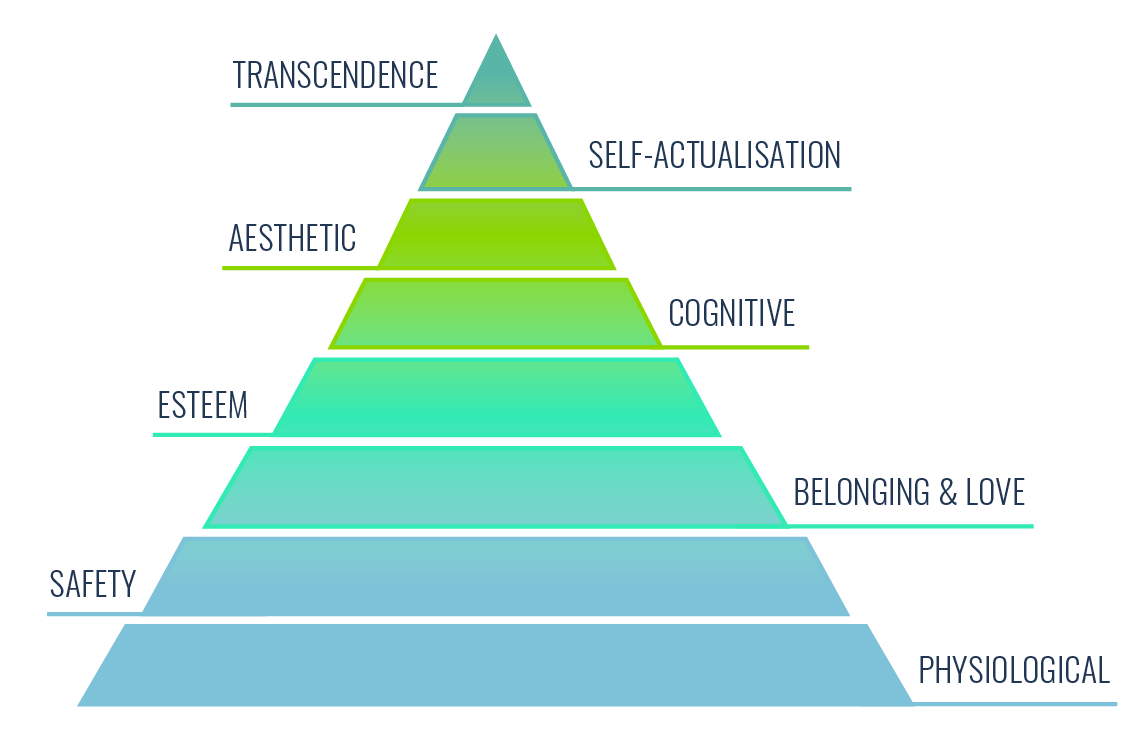
As such, 27-years after first introducing his theory, he decided to expand it. He did this by slotting in three new needs — two below ‘self-actualisation’ and one above it.
- Cognitive needs: These needs relate to our desire to learn, build our knowledge, and develop our skill sets. After all, most of us seek to understand the world around us. Cognitive needs can include creativity, foresight, curiosity, and meaning.
- Aesthetic needs: These needs relate to our desire for beauty, order, and harmony in our lives. They are often linked to a profound appreciation of art, music, literature, architecture, nature, and other forms of expression.
- Transcendence needs: These needs are linked to our desire to go beyond our physical being in search of meaning. They include needs like helping others, spiritual connection, philosophical exploration, and even mystical experiences.
As Maslow puts it, transcendence refers to the ‘very highest and most holistic level of human consciousness, behaving and relating, as ends rather than means, to oneself… to human beings… to nature and to the cosmos.’
In other words, Maslow’s update gives us something bigger than self-actualisation to strive towards. After all, at the very top of his hierarchy, we move past self-interest and find a higher purpose in something greater than ourselves.
Applying Maslow’s Hierarchy to Learning Contexts
Let’s consider the implications of Maslow’s theory for learning professionals. As learning is a ‘growth need’, it sits at the very top of his original hierarchy. As such, we know that it’s difficult for us to learn if our lower level needs are left unsatisfied.
- You’re unlikely to want to learn to play the piano if you haven’t eaten in 24 hours.
- You probably won’t open Duolingo if your house is on fire.
- Similarly, if something jeopardises your safety, you won’t be very interested in completing your compliance training.
Simply put, Maslow comes before Bloom. We also need to recognise that as learning professionals, there’s only so much we can do to satisfy our learners’ physiological needs. However, we can and should be aware of them and the impact they have on motivation. In turn, this awareness should drive understanding and empathy.
Instead of growing frustrated when learners struggle to make progress, we should pause and reflect. At this stage, we should consider which physiological issues are affecting our learners’ motivation levels. Then we can see if there’s anything we can do to help.
Where possible, we should also create learning environments that help to meet these different needs. After all, if we can achieve this then motivation should be easy to come by. With this in mind, here are our five top tips (+1 bonus suggestion) for improving your learning experiences by climbing Maslow’s hierarchy.

Tip 1: Ensure Your Learners Feel Safe
As we’ve seen, safety and security are a basic need. As such, creating a safe and welcoming learning environment is crucial to the success of your digital learning programme. Where necessary, you may even need to provide specialised support for certain learners.
Take care to establish clear and transparent guidelines, codes of conduct, and anti-discrimination policies for your learning platform. Ensure these are communicated to your audience and that you have moderation and monitoring mechanisms in place.
Furthermore, you should always focus on the benefits (‘WIIFM‘) of completing your training content, rather than any potential negative consequences.

Tip 2: Create a Sense of Belonging
The third level of Maslow’s hierarchy tells us that motivation and a sense of ‘belonging’ are intrinsically linked. To generate this sensation, you should offer your learners opportunities to collaborate and compete with one another.
On a learning management system, you should use features like social streams, forums, expert areas, FAQs, and live chat to create an incentivised knowledge sharing community. Setting users up as ‘experts’ can also satisfy a desire for status.

Tip 3: Build Esteem With Gamification
Game mechanics like Badges, Experience Points, Levels and Leaderboards are powerful motivational tools. They help us to meet our need for ‘esteem’, which can be found on the fourth level of Maslow’s hierarchy.
Virtual rewards give us a sense of achievement and improve our reputation within the learning environment. Gamification also helps to make learning more fun, encouraging repeat visits and improved knowledge retention.

Tip 4: Treat Your Learners Like Actualised Individuals
Provide opportunities for your learners to take ownership of their learning journey. Offer your audience choice and autonomy. You can achieve this through branching learning pathways, scenario-based learning or even immersive learning experiences.
Encourage critical thinking and problem solving. Ask your learners to reflect on what they’ve learned and apply it to their day-to-day life. Foster a culture of curiosity by encouraging questions and queries. Then seek out and action learner feedback.
All these steps help your learners to come closer to realising their potential and achieving true self-actualisation.

Tip 5: Transcend Through Epic Meaning
The final level of Maslow’s original hierarchy focuses on self-growth. Working towards your purpose builds this connection. As such, we recommend imbuing your learning environment with as much Epic Meaning as possible.
Epic Meaning is the sense of higher purpose that fuels our passion for a cause. In fact, it could easily be linked back to the transcendence needs listed in Maslow’s expanded hierarchy.
In a business context, your epic meaning is powered by your mission, vision, and values. As such, you should take every possible opportunity to customise your learning environment and create a narrative in line with these assets.
Go Further: Elevating Learning Through Humanistic Design
While these tips apply to Maslow’s hierarchy, truly embodying his principles means adopting humanistic psychology. This is a paradigm shift from traditional education to heutagogy, where learners reclaim ownership of their journey. In doing so, this approach:
- Makes growth and well-being non-negotiable
- Transforms educators into empowerment architects
- Demands equal focus on cognitive and affective domains (see table below)
| Domain | Focus | What’s Covered |
| Cognitive | Intellectual skills and knowledge | Remembering facts, understanding concepts, applying knowledge, analysing information, evaluating ideas, and creating solutions. |
| Affective | Emotions and attitudes | Receiving, responding, valuing, organising, and internalising emotions, attitudes, and values. |
A humanistic learning approach doesn’t just educate, it elevates! It nurtures both cognitive mastery and emotional growth. Want to master this balance? We’ve got you covered with a full guide on the topic.
Final Word
Abraham Maslow’s hierarchy is now over 80 years old. But despite showing signs of age, it still packs a powerful theoretical punch. After all, it helps us to deepen our understanding of motivation, goal attainment, and personal fulfilment.
It also provides structure and clarity to an area of human psychology that previously seemed to be difficult to parse. The simplicity of the hierarchy has helped Maslow’s theory to maintain its influence over the years.
It should also give learning professionals pause for thought. The model shows us that people don’t avoid learning because they are lazy. They struggle because other more pressing needs are asserting their dominance and are redirecting their motivation.
However, if we can provide support through our interpersonal relationships and technology platforms, then we can help learners to climb the hierarchy. Once they reach the tip of the pyramid and begin to self-actualise, there’ll be no stopping your learners.
Thanks for reading. If you’ve enjoyed this content, please connect with me here or find more articles here.
Do you have a need for more learning theory-focused content? Then you’re in luck. Download ‘Using Learning Theories & Models to Improve Your Training Initiatives’ now!

